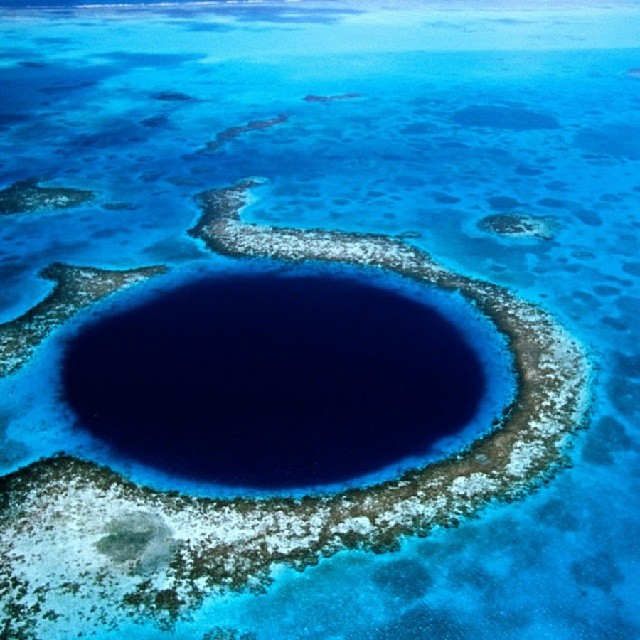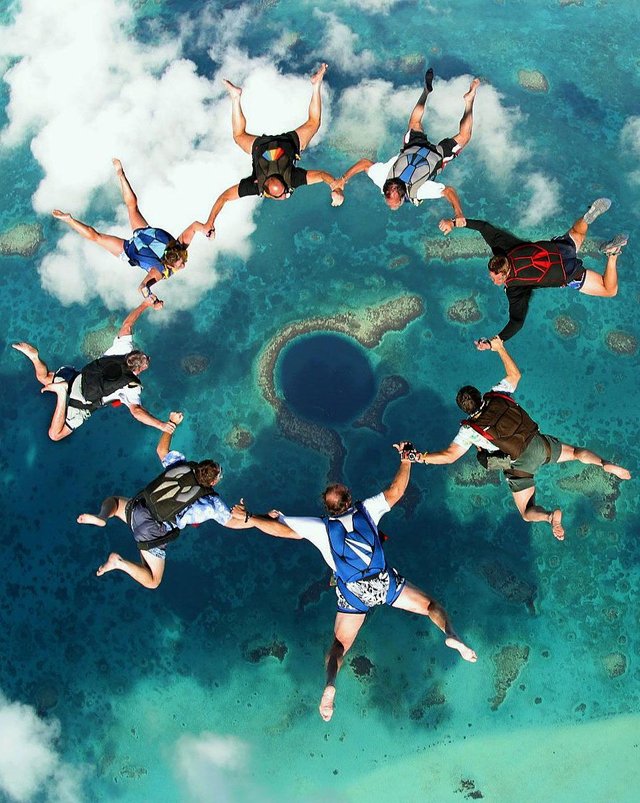Great Blue Hole 🏞
Great Blue Hole
Great Blue Hole is a submarine cenote located off the coast of Belize, Central America. It is protected within the coral reef of Belize.

The hole is almost circular, with a diameter of more than 300 meters and a measured depth of 124 meters.
At the origin of its formation, during the last ice age when sea levels were much lower, it was a limestone cave. When the level of the ocean rose, the underground cavities were flooded, and the roof of this cave collapsed.
The cenotes are chasms or avens (abyss, geological formation characteristic of the karst regions) An aven is a cavity whose access opens in the ground and which presents on all or part of its development the shape of a well, this which makes it difficult to access without specific material.
The dimensions of the opening on the surface of these cavities are variable: from a few decimeters to two hundred meters, just as the depth can be impressive), or collapse sinkholes (form Characteristic of limestone erosion The dissolution of surface limestone leads to the formation of circular depressions ranging from a few meters to several hundred meters in diameter and their bottom is often occupied by clays, fertile and more or less impervious.
Local water supply makes them suitable for the development of a specific microclimate and rich vegetation, giving them a habitat and possibly natural refuge for many species), in karstic environment, totally or partially filled with a superficial layer of fresh water and sometimes a lower layer of sea water if they communicate with the ocean by faults or other conduits.
They are found mainly in North and Central America, and especially in the Yucatán peninsula in Mexico. They act as natural wells that can reach several tens of meters deep.
When a cenote is submerged under a lagoon or other body of water, it is called a blue hole.
The cenote Zacatón, in northeastern Mexico, is the deepest known in the world.
An autonomous diving robot explored and mapped it. It reached its bottom at 318 meters deep in May 2007.
The Mayas considered these wells as a means of communication with the gods of the infra-world, the chasm representing a mouth. They used them as a reserve of fresh water but also as a place of worship in which offerings or sacrificial victims were thrown.
The remains of this cultural heritage have important historical and scientific value. They are protected by the Convention on the Protection of the Underwater Cultural Heritage.

Creation

The cenotes are produced by a phenomenon of dissolution and collapse of limestone lands located above an underground network of caves and rivers. They are found both in picturesque places in the jungle and in the city.
In Yucatán, a ring of cenotes is arranged concentrically around the crater of Chicxulub; therefore, their training is attributed to the impact of a meteorite 10 km in diameter, which also caused the extinction of the dinosaurs about 65 million years ago 🐾
The cenotes in the Yucatan area are for the most part connected by a system of aquatic caves, which would have been created during the impact of the meteorite.
When the orifice of a cenote is situated below the surface of a body of water, it appears in the form of a darker spot; then we speak of blue hole or black hole according to the perceived color.
Notoriety
This site was made famous by Jacques-Yves Cousteau who declared it as one of the top ten diving sites in the world. In 1971, he came with his boat, the Calypso, to draw a map of its depths.
I find it very beautiful and mysterious and being a former diver, I would like to go there for a little dive. It must be impressive to dive right into this blue hole. I'm curious to see what lies beneath…
Sky drive is better felling. I like sky drive.
Beautiful. The colors look stunning.
Interesting facts, I saw programs in which people talked about this place. This is a beautiful and at the same time a mysterious place. It attracts attention of both scientists and tourists and divers. There is a big blue hole in one of the most beautiful places on earth.
this kind of information only inflames the interest in learning from many people.
Thank you
Hey sorry, i was trying to upload my image as a display picture on profile. Iam Sana here, a Biotechnologist, creative writer, poetess , feminist and a lover of arts and nature so came across your profile as inspired by nature.
i must say iam mesmerized by your eye catching article and sceneries that are so impressive and too pretty to be real. Most importantly full of life , enthusiasm and vigour.
wow....it's just awesome....
thank's for sharing...resteem done
Wow. What a lovely scene! Id love to see that in person one day.
Great blue hole is actually the Earth’s butthole. Go in at your own risk 😷
Wow.. misterious but amazing
https://www.facebook.com/photo.php?fbid=1366091886786510&l=1864544c8c
its really interesting holes i really exited to hearing about this thanks for increasing my informations.